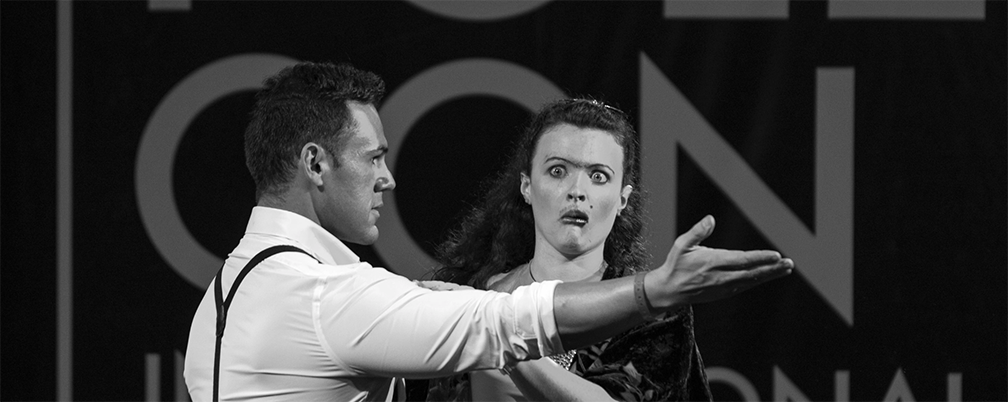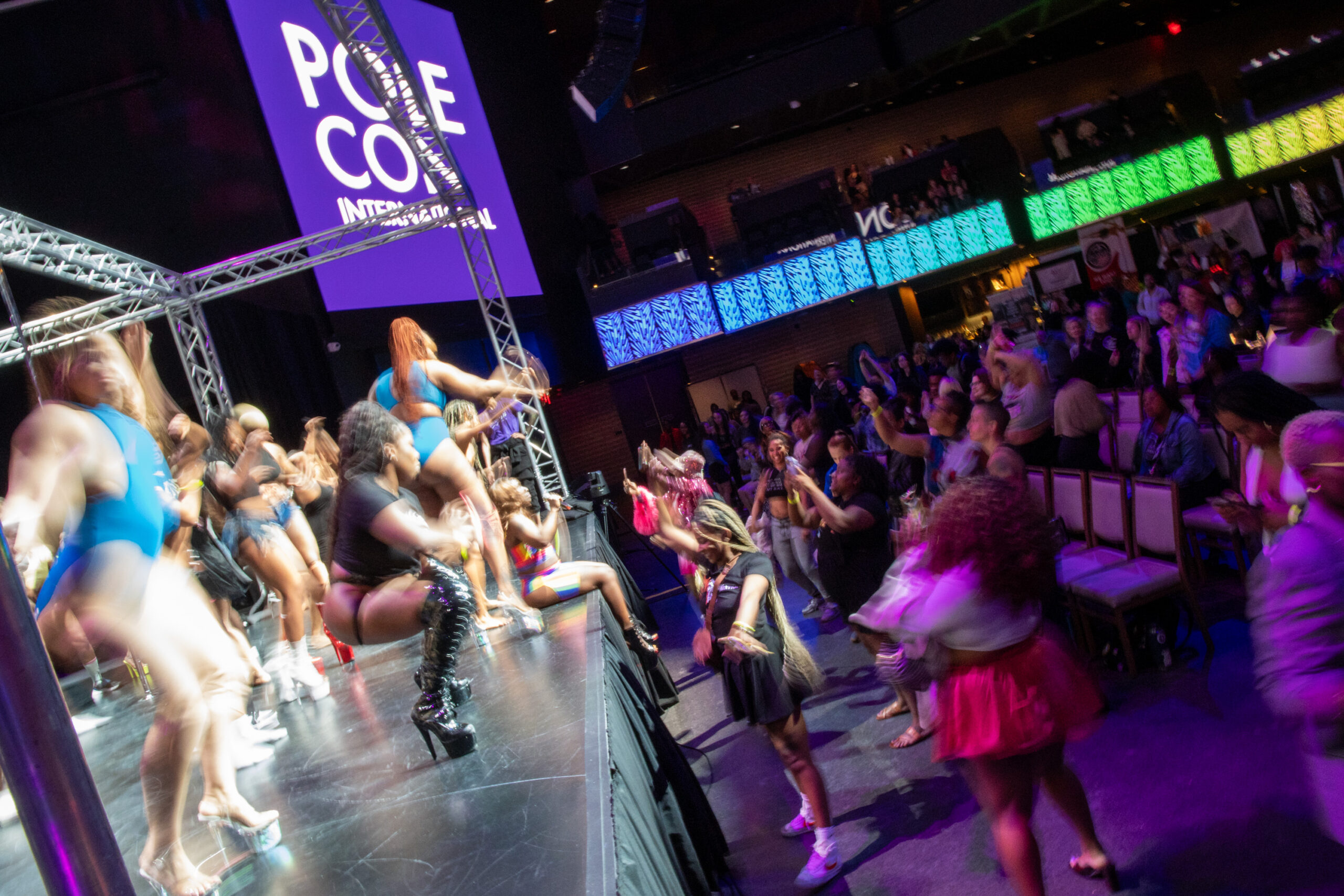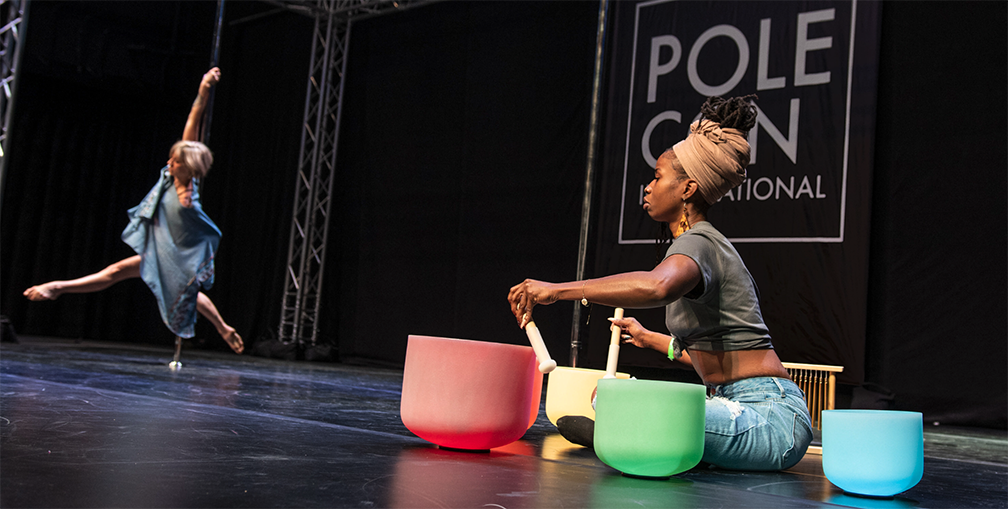Thank you to everyone who took our survey! We read every response. <3 *this is…

Pole Comedy: the what’s and how’s of this funny business
This post, originally written and published in 2015, referenced an article written in 2014 about the “Rise of Pole Comedy.” 10 years later, I’m updating the content and resharing since Pole Comedy is DEFINITELY here to stay!
What is pole comedy?
In 2014, Danielle Christine wrote an article about the “Rise of Pole Comedy” (which sadly no longer exists on the internet; it published originally on the Bad Kitty blog) noting that with pole stars like Carlie Hunter getting in on the act with her “Carlos” routines and Annemarie Davies with her infamous “Pedro” routine combined with up and coming stars bringing comedic interpretations to established competitions like PSO, pole comedy is definitely on the rise.
As of 2015 and to this day, Pole Theatre with competitions in the UK, South Africa, Australia, and now the US, specifically established pole comedy as its own competitive category with the requirement of “incorporation of comedic elements and audience engagement” worth more than any other requirement, eclipsing even “pole skill.”
PoleCon introduced the Pole Comedy showcase in 2016 and has run it every year since. It has been curated for many years by the Pole Comedian.
Pole comedy isn’t just on the rise—it is here to stay. So how do you do it?
Comedy as a concept is loosely defined as something that will make an audience laugh. What elicits a laugh changes and varies wildly depending on the audience and what to them, in that time and in that relevant context, is funny.
Ancient Greece is the birthplace of western comedy, which popularized dramatic juxtapositions of divergent viewpoints in political discourse and later broadened the concept to include any story that ended happily, the ultimate opposition to tragedy.
Comedy as a genre has evolved to include a multitude of high brow and low brow, vocal and physical, social commentary and fantastical impossibilities, sexual and appropriate for children derivatives however at its core what makes something funny is it’s subversion or contrast to an existing thought and how it is packaged or delivered for a specific audience.
Pole and dance in general is simply another story telling mechanism and just as you can tell a story with your voice or the written word, you can also tell a compelling story or even a joke, which sometimes masquerades as a story, with your movement.
“Is this funny to you???” Be Your Authentic Self
Step one in your pole comedy journey is to determine what is funny to you.
Do you like slapstick? Or do you prefer parody? What about ventriloquism? Know that what is funny to you may not be funny to your audience however; being authentic in your performance is key to connecting with those that will find you funny. Trying to be funny and mimicking someone else that you find funny will often fail. Find your own “brand” of funny and channel concepts and emotions that you enjoy and value.
On entering my first PSO competition, I applied to the entertainment category because I personally enjoy entertaining and upbeat performances more than dramatic or even sexy ones. I enjoy story telling and wanted to engage my audience in a fun way while also communicating a message. In my life outside of pole I do a lot of training and have found that a little bit of career-relevant information packaged in a lighthearted way (self-dubbed “edu-tainment”) was significantly more effective for keeping my audience awake, engaged and applying what they learned. They remembered my stories and the times I made them chuckle even with fairly dry subject matter. Perhaps the same could be applied to pole!
I thought some more about who are the funniest (to me) songsters and how they might help me show my most authentic self. I settled on Weird Al, the funniest, dorkiest singer I could think of and used his parody “White and Nerdy” to craft a story about a terrible ballerina who comes into her own when she finally gives up all pretense and proudly let’s her nerd flag fly.
To me, I was hilarious and on point with my story that pole should not be interpreted in one way but has a variety of authentic experiences, however performing it early in the morning to a small and un-caffeinated audience—let’s just say the laughs were few and far between.
“He’s the funniest man alive!” “Then I must be dead”—Know Your Audience
Before any performance or competition, learn as much as you can about the audience, the judges, and the details of the venue before crafting your pole-formance. Some venues that have access to advanced lighting and encourage a full extravaganza will have a distinctly different crowd than a local competition in a bar or club.
If your goal is to be your authentic self—just, be you!
But know that while you think you’re funny, your crowd may not be in on the joke. If your goal is to win a competition, knowing your audience, judges, and venue are critical to success. Don’t lose your authentic self but do modify your performance to better suit the environment.
For instance, the “White and Nerdy” routine described above, was a tough sell at 9am on a Sunday. It did quite well at 10pm on a Friday in a bar, especially when my personal “hype man” friend armed with such well-timed pole phrases as “I know HER!!!” and “GET IT” encouraged the rest of the audience to cheer and laugh my terrible ballerina on to victory.
“Details Smetails,” Props, costumes, and movement
While many performances that tell a complex story or channel a specific character benefit from more than your standard sports bra + bedazzled brazil costuming, pole comedy absolutely needs quality details to enhance the experience. Spend time on your costume and confirm that all details can be “read” from far away while adding and not detracting from your performance.
The same goes with your props.
Successful use of props can enhance a character and provide much needed details about character motivation and/or move the story along (such as when Sergia Louise Anderson’s 2013 PSO National winning clown burst their bubble mid performance signifying a change in character motivation timed with the music).
Unsuccessful props are used once and ignored. If you are going to use props, integrate them into your performance and if you can’t find a way to do that then you don’t need a prop.
Your movement should also reflect your character and/or story. Slightly changing the details of your movement such as purposely-flexed feet to signify something childlike or mimicking a phrase in your song with hand gestures while in a pole pose will enhance your story. Just make sure that whatever movement you are doing, you do the f*ck out of it. You reach all the way to the “cheap seats” so your story and details can be clearly understood.
Liz Kinnmark in her “Strong Man” routine is the perfect embodiment of quality costuming, prop usage and using movement to express her character and story comedically. Her commitment to costuming makes us forget her female form and focus on the mustachioed hero who goes through a transformation of becoming a “strong man.” She consistently finds unique ways to engage with her barbell prop, integrating it into both on and off the pole movements while encouraging the audience to laugh with her.
“I’m so happy, can’t you tell?” Fix your face
While most might include facial expressions as part of your details, in pole comedy, the face is the most important movement detail and is worthy of separate discussion. In physical comedy a “prat fall” is a purposeful fall often onto the booty. In real life, when a friend falls on their butt, you rush to assist because of the pained look on their face. If someone falls during a performance and their face reflects a different emotion—like shock, humor, or surprise—suddenly a movement that should elicit empathy on physical pain, elicits a laugh instead because we’ve been specifically told that it’s funny and ok to laugh.
Your face is the barometer of how funny your performance is supposed to be.
If you believe you’re funny and show you’re funny in your face, your audience knows to laugh and not to call 911.
When using your face, make sure to over exaggerate your emotions and enhance your features with makeup. Your emotions and intentions should be clearly shown on your face even more so than being reflected in your movements. Keep your face moving during your performance, rather than having a wide-eyed, rictus smile stuck on your face, and if you’re having trouble understanding what to do with your face while dancing, work on it separately by making faces at yourself in the bathroom mirror and then graduate to making faces at your friends or significant others to gauge their reactions.
In pole comedy, more is more with regards to your face so ham it up.
“But I told a good joke, where did everyone go?” Point your f*ckin’ toes
Pole comedy while funny is still also about pole dancing.
If you are competing, do not sacrifice time to perfect your physical movement with time to perfect your costume. Yes, being funny in the face and having a great costume and prop is absolutely important but so is your execution.
Especially in a competition, even one geared towards this genre, you must still execute pole moves successfully without looking like you’re going to die the minute you go off stage. Practice your tricks and moves as full out as possible every time incorporating all movement details that enhance your story, especially your face.
If you are NOT competing, don’t listen to the advice above. Be you and bring your vision to life!
The End?
If you’ve read through this and thought, “hmmm, those tips seem like they can apply to any performance!” you’re absolutely right.
These are, at least in part, good general ways to engage your audience, enhance your movements, and remember how to truly perform and not just do trick after trick. The difficulty with pole comedy is not just telling a story or providing a message but also actually getting people to laugh and enjoy themselves.
The job of a comedian is hard, and it is often said that those with a true gift like the late, great Robin Williams, are often sad themselves and making others laugh is a way to cope with their own darkness. Pole comedy may be that release and when done effectively and the audience is truly engaged as well can provide a welcome respite from the terrors of the modern world for all involved.
More than two people will disagree on what they find funny so the job of the pole comedian in an industry dominated by sexy and serious pole-formances is absolutely a challenge to place or win competitions that are not specifically for their genre. Just because it can be tough does not mean it’s not worth it.
Go forth, pole comedians and be funny, or at least be you and that might be funny enough.
Latest posts by Colleen (see all)
- PoleCon 2025 Updates from the Survey - June 20, 2025
- PoleCon Hub Page: MORE Black Voices - June 13, 2025
- PoleCon 2025: Recap - June 4, 2025


